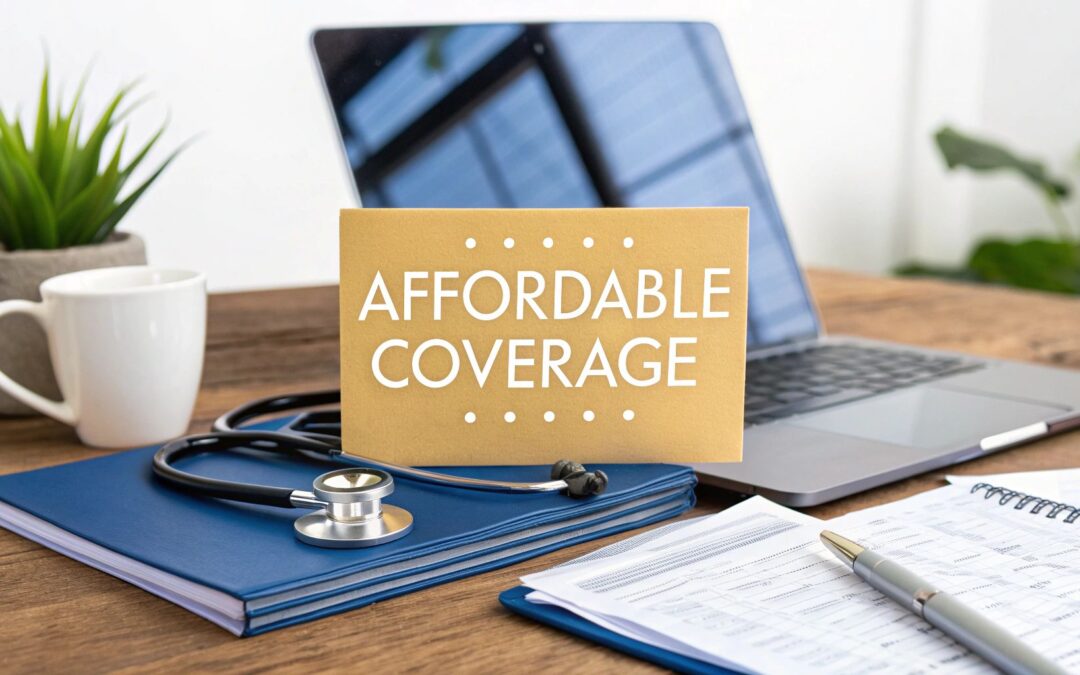Figuring out healthcare for self employed professionals can feel like navigating a maze, but it really comes down to four main paths. Your choices generally fall into one of these buckets: government-run ACA Marketplace plans, private insurance you buy directly, Health Savings Accounts (HSAs) linked to high-deductible plans, or alternative options like health sharing ministries.
Why Finding the Right Healthcare Matters
Let's be real—when you're your own boss, you're also the head of HR. That means getting health insurance is all on you, a job that can feel both confusing and incredibly expensive.
Without an employer chipping in, you're on the hook for the entire premium. That can be a huge hit to your bottom line. This guide is your roadmap to understanding the landscape of healthcare for self employed people, built to cut through the noise and get straight to what you need to know.

Think of this as a step-by-step journey to build your confidence. By the time we're done, you'll have a clear, actionable plan to get the coverage you and your family deserve. For an even more detailed look, check out our complete guide to self-employment health insurance.
The Financial Reality for Freelancers
The number of people striking out on their own has skyrocketed, making independent work more common than ever. But with that freedom comes a unique challenge: healthcare.
Self-employed individuals have to cover their own insurance premiums, which are not only subject to market rates but also the federal self-employment tax. This tax currently sits at 15.3%, with 2.9% going toward Medicare. That's a hefty extra layer of cost on top of your monthly insurance payment.
The biggest hurdle isn't just finding a plan; it's finding one that protects your health without wrecking your business's cash flow. The secret is to truly understand all your options before you commit.
This guide will walk you through every path, from subsidized marketplace plans to smart savings strategies that can make a real difference. We'll give you a clear overview so you can see the entire landscape at a glance.
A Quick Look at Your Top Options
To help you get your bearings, here is a simple breakdown of the main avenues you can explore. Each one has its own strengths, depending on your income, health needs, and how much risk you're comfortable with.
Your Top Health Insurance Pathways at a Glance
This table gives you a quick summary of the main health insurance options out there for freelancers and entrepreneurs. Use it to get a feel for which direction might be right for you.
| Insurance Pathway | Best For | Key Feature |
|---|---|---|
| ACA Marketplace | Individuals needing financial assistance or with pre-existing conditions. | Potential for significant premium tax credits and subsidies. |
| Private Off-Marketplace | Those who don't qualify for subsidies and want more plan choices. | Greater network flexibility and a wider variety of plans. |
| Health Sharing Ministries | Healthy individuals seeking a lower-cost, community-based alternative. | Lower monthly contributions, but not actual insurance. |
| Short-Term Plans | People needing temporary coverage between long-term plans. | Inexpensive, immediate coverage for catastrophic events. |
Think of this as your starting point. As we go, we'll dive deeper into what makes each option tick, so you can make a choice that feels right for your life and your business.
Figuring Out the ACA Health Insurance Marketplace
For a lot of us who are self-employed, the first place to look for health coverage is the Affordable Care Act (ACA) Health Insurance Marketplace. Think of it as a dedicated online hub for health insurance, designed to make it simple to compare plans and see if you can get financial help. Everything is laid out in one spot, so you can see all your options side-by-side.
The ACA really changed the game for healthcare for self employed folks, making coverage more reachable than ever. In fact, between 2013 and 2022, the number of self-employed people on Medicaid shot up by about 1.3 million, mostly because the ACA opened up access to public health insurance.
Understanding the Metal Tiers
When you start browsing the Marketplace, you’ll see plans grouped into four "metal" tiers: Bronze, Silver, Gold, and Platinum. This isn't about the quality of medical care you receive—it’s all about how you and your insurance plan split the costs.
It’s like you and your insurer are partners chipping in for your healthcare. The metal tier just decides who pays what.
- Bronze Plans: You’ll pay the lowest monthly premium, but you'll have the highest costs when you actually need care. It’s like having a high-deductible car insurance policy—it’s cheap month-to-month, but if you get in a wreck, you’ll pay more out of your own pocket.
- Silver Plans: These strike a balance with moderate monthly premiums and reasonable costs when you see a doctor. There's a reason they're the most popular choice, and they come with extra savings if you qualify.
- Gold Plans: With these, you’ll have a higher monthly premium, but the plan picks up more of the tab when you need treatment. This is a great fit if you know you’ll be using your insurance pretty regularly.
- Platinum Plans: These come with the highest monthly premiums but the lowest out-of-pocket expenses. You’re essentially paying more upfront to keep your costs predictable and low when you need care.
The right tier really comes down to your health, your budget, and how much risk you're comfortable with. A healthy freelancer might feel great about a Bronze plan's low premium, while someone managing a chronic condition could save a lot more overall with a Gold plan.
The Real Game-Changer: Financial Subsidies
This is where the Marketplace becomes incredibly powerful for the self-employed. Subsidies can slash your costs, sometimes dramatically. There are two main kinds of financial help you can get.
1. Premium Tax Credits
These credits directly lower your monthly insurance bill (your premium). How much you get depends on your estimated household income for the year. With these credits, many people find their coverage costs $10 or less per month. You can have the credit sent straight to your insurer to lower your bill each month, or you can claim it all when you file your taxes.
2. Cost-Sharing Reductions (CSRs)
These are extra savings that cut down what you pay out-of-pocket for things like deductibles, copayments, and coinsurance.
This is huge: To get Cost-Sharing Reductions, you MUST sign up for a Silver plan. These "Enhanced Silver" plans give you the value of a Gold or even Platinum plan but at a Silver price—an amazing deal if your income qualifies you.
These subsidies make solid healthcare for self employed people a realistic goal instead of a financial headache. If you want to take a closer look at the different paths you can take, check out our guide on health insurance for the self-employed.
How to Get Through the Enrollment Process
Signing up for a plan is pretty straightforward, but timing is critical. This little infographic simplifies the journey you'll take.

This visual breaks down the process into three main steps: figuring out what you need, comparing the financial trade-offs, and then making your choice.
The most important time of year is Open Enrollment, which usually runs from November 1 to January 31 in most states. This is the one time when pretty much anyone can sign up. If you miss that window, you can only enroll if you have a Qualifying Life Event (QLE)—things like losing other health coverage, getting married, or having a baby.
Exploring Your Options Beyond the Marketplace

While the ACA Marketplace is a fantastic starting point for finding healthcare for self employed folks, it’s not the only road you can take. Sometimes, venturing “off-marketplace” can lead you to a plan that’s a better fit, especially if your income is too high to get any help with your premiums.
Think of it like this: The Marketplace is a bit like a curated department store, stocked with options that come with government-backed discounts. But going directly to an insurer is like visiting a brand's flagship store—you might just find a wider selection or different models that weren't on display elsewhere.
Going Direct with Private Insurance Plans
One of the most straightforward alternatives is buying a health plan directly from an insurance company. This is what we call an "off-exchange" or "private market" plan. It’s important to know these plans are still ACA-compliant, which means they have to cover essential health benefits and can’t turn you away for pre-existing conditions.
So, why go this route? The main draw is often a greater variety of choices. Insurers sometimes offer plans with different provider networks or benefit structures that you won't find on the Marketplace. This is a huge plus if you need to make absolutely sure a specific doctor or hospital is in your network, and they don't happen to participate in the exchange plans.
Just remember the one big catch: those valuable subsidies, like Premium Tax Credits, are only available for plans you buy on the Marketplace.
The Low-Cost Lure of Short-Term Health Plans
You’ve probably seen the ads—health plans that seem almost too cheap to be true. These are usually short-term, limited-duration insurance (STLDI) plans. They were created to be a temporary bridge for people between jobs or waiting for other coverage to kick in. That low price tag is tempting, but it comes with some serious trade-offs.
It's absolutely critical to understand what these plans are not. They are not comprehensive coverage.
- No Pre-existing Condition Coverage: They can, and often will, refuse to cover any health issue you had before the plan started.
- Limited Benefits: They aren’t required to cover the ACA's ten essential health benefits. That means they can leave out things like maternity care, mental health services, or prescription drugs.
- Coverage Caps: Many of these plans put an annual or lifetime limit on how much they’ll pay. A serious accident or illness could leave you with massive bills.
Short-term plans might feel like a quick, easy fix, but they offer a very thin safety net. You're essentially gambling with your health—they might cover a sudden, unexpected new problem, but they leave massive gaps that could be financially devastating.
Understanding Health Care Sharing Ministries
Another path you might come across is a health care sharing ministry (HCSM). These are faith-based organizations where members contribute monthly payments, often called "shares," into a collective fund. When a member has a qualifying medical bill, they submit it to the group to be "shared" by the community.
Let's be crystal clear on one thing: health sharing ministries are not insurance. They are not regulated by state insurance departments and offer no guarantee that your medical bills will actually be paid.
How Sharing Ministries Differ from Insurance
| Feature | Traditional Insurance | Health Sharing Ministry |
|---|---|---|
| Payment Guarantee | Legally obligated to pay for covered claims. | No legal guarantee of payment; relies on member contributions. |
| Regulation | Heavily regulated by state and federal law. | Generally not regulated as insurance. |
| Pre-existing Conditions | Must cover under ACA rules. | Often have waiting periods or permanently exclude pre-existing conditions. |
| Lifestyle Rules | No lifestyle requirements. | Typically require adherence to a statement of faith or specific lifestyle standards. |
For a healthy person who aligns with a ministry's beliefs and is comfortable with this model, an HCSM can seem like a lower-cost way to handle big medical bills. But you are absolutely accepting more financial risk. You have to be ready to cover routine costs on your own and understand that payment for a major health event is voluntary, not contractual. This path demands very careful thought and a full understanding of the risks you’re taking on.
Using an HSA to Your Financial Advantage
When you're self-employed, every financial tool counts. But if there’s one that truly stands out for managing healthcare costs, it’s the Health Savings Account (HSA). Too many people miss out on its power, but it’s so much more than just a savings account.
Think of it as a personal healthcare fund with incredible tax perks—almost like a supercharged retirement account, but for your health. An HSA isn't just for today’s doctor visits; it's a long-term strategy that helps you build wealth while covering your medical needs.
What makes an HSA so special is its "triple tax advantage." It’s a combination you just won't find anywhere else.
- Tax-Deductible Contributions: The money you put in is deductible, which means it lowers your taxable income for the year. Simple as that.
- Tax-Free Growth: Your money can be invested, and any earnings it generates grow completely tax-free.
- Tax-Free Withdrawals: When you need to pay for qualified medical expenses, you can pull money out without paying a single cent in taxes.
This trifecta makes an HSA an incredible tool for both present-day needs and future financial security.
The Key to Unlocking HSA Benefits
There's one catch, but it's a straightforward one. To open and contribute to an HSA, you must be enrolled in a High-Deductible Health Plan (HDHP).
An HDHP is exactly what it sounds like: a health plan with a higher deductible than you might be used to. In exchange for you covering more of your initial costs, these plans almost always come with lower monthly premiums, which is a huge win for any freelancer or business owner's budget.
The government sets the rules for what counts as an HDHP each year, including the minimum deductible and a cap on your total out-of-pocket costs. This setup encourages you to be more mindful of your healthcare spending while giving you a powerful, tax-free way to save for those expenses.
To give you a clear picture, here are the numbers you need to know for this year.
HSA Contribution Limits and HDHP Requirements
| Filing Status | Annual HSA Contribution Limit | Minimum Annual Deductible (HDHP) | Maximum Out-of-Pocket (HDHP) |
|---|---|---|---|
| Self-Only | $4,150 | $1,600 | $8,050 |
| Family | $8,300 | $3,200 | $16,100 |
These figures help you see how the pieces fit together—the contribution you can make to your HSA is directly tied to having a plan that meets these specific deductible and out-of-pocket standards.
How to Use Your HSA for Maximum Impact
Once you're set up with a qualifying HDHP, opening an HSA is easy. Most banks and investment firms offer them. You can fund it directly, and that money is yours to keep forever. It rolls over year after year, and it stays with you even if you change jobs or health plans.
For 2024, you can contribute up to $4,150 for an individual plan or $8,300 for a family plan. And if you're 55 or older, you can throw in an extra $1,000 "catch-up" contribution.
An HSA pulls double duty. It’s your emergency fund for today’s medical bills and a powerhouse retirement account for tomorrow. After you turn 65, you can take money out for any reason at all—not just medical—and it works just like a 401(k), where you only pay regular income tax.
This is what makes the HSA a true cornerstone of financial planning for the self-employed. You can pay for deductibles, copays, dental work, or new glasses with pre-tax dollars. At the same time, any money you don't use can be invested to grow into a healthy nest egg for your future.
Pairing a low-premium HDHP with a tax-advantaged HSA creates a smart, cost-effective system for taking control of your healthcare finances. To see how this fits into your bigger financial picture, check out our guide on health insurance tax benefits.
Actionable Strategies to Reduce Your Healthcare Costs

Finding a health plan is the first big hurdle. But the real win comes from actively managing what you spend on healthcare for self employed professionals day in and day out. It’s not just about paying that monthly premium; it’s about making smart moves to keep more of your hard-earned money.
These proven strategies can put you back in the driver's seat.
The most powerful tool in your financial toolbox? The Self-Employed Health Insurance Deduction. This isn't some complex accounting maneuver. It's a straightforward, above-the-line deduction that directly lowers your adjusted gross income (AGI).
This means you can write off 100% of the premiums you pay for medical, dental, and even qualifying long-term care insurance. It covers you, your spouse, and your dependents. Best of all, you don’t even need to itemize to claim it, making it an incredibly accessible and high-impact benefit for any profitable freelancer or business owner.
Leverage Modern Care With Telehealth
One of the biggest game-changers in healthcare has been the rise of virtual care. Telehealth isn't just for a minor cold anymore; it's a powerful tool for everything from routine check-ups and specialist follow-ups to essential mental health support.
Healthcare costs keep climbing everywhere, with some projections showing a potential increase of 10.2% in 2025 alone. But telehealth and virtual care are helping to soften that blow by making healthcare easier to access and, often, more affordable. It's become a key way to lower overall claims costs.
Using telehealth saves you from a trip across town and the costs that go with it. Plus, virtual visits often come with a lower copay than seeing a doctor in person. It’s an efficient, cost-effective way to get the care you need without derailing your workday.
Build Your Cost-Saving Toolkit
Beyond big deductions and virtual care, small, consistent habits can lead to huge savings over time. It all comes down to being a proactive and informed healthcare consumer.
Think of your healthcare spending like any other business expense. You wouldn't approve a major invoice without reviewing it first. Apply that same diligence to your medical bills.
Here are a few practical tips you can start using today:
- Always Review Your Medical Bills: Billing mistakes happen more often than you'd think. Take a few minutes to look over every Explanation of Benefits (EOB) and bill you get. Question any charges that look off or that you simply don’t recognize.
- Don't Be Afraid to Negotiate: If a large, unexpected medical bill lands in your lap, many hospitals and providers are willing to negotiate the price, especially if you can pay a portion of it right away. You can also ask for an itemized bill, which sometimes reveals inflated or bundled charges.
- Embrace Generic Drugs: Generic medications are chemically the same as their brand-name versions and are fully approved by the FDA. They can cost up to 85% less, giving you one of the single best ways to lower your pharmacy spending without compromising on quality.
- Use Free Preventive Care: Every ACA-compliant plan is required to cover a list of preventive services at no cost to you. This includes things like annual check-ups, immunizations, and various health screenings. Taking advantage of these helps you catch potential issues early, saving you from much more expensive treatments down the road.
Making these habits a part of your routine can seriously lower what you spend on healthcare each year. Sometimes it's hard to know whether to use insurance or just pay out-of-pocket, and our guide on health insurance vs. personal savings can help you make that call with confidence.
Answering Your Top Healthcare Questions
Diving into the world of healthcare for the self-employed always brings up a lot of questions. Getting clear, straightforward answers is the key to feeling confident in your decisions. Let’s walk through some of the most common concerns that freelancers and entrepreneurs face.
Can I Get Health Insurance with a Pre-existing Condition?
Yes, absolutely. Thanks to the Affordable Care Act (ACA), an insurance company can’t legally deny you coverage or charge you more just because you have a pre-existing condition. This is one of the most important protections built into every ACA-compliant plan.
This rule holds true whether you’re shopping on the official Health Insurance Marketplace or buying directly from an insurance provider. It’s a critical safety net for anyone who’s self-employed.
It's important to know this protection does not apply to plans that aren't ACA-compliant, like short-term health insurance. Those plans can—and often do—reject you for past health issues, which makes them a much riskier bet if you have any medical history.
What Should I Do if My Income Changes During the Year?
Freelance income almost never stays the same, and the healthcare system is built to handle that. If you have a Marketplace plan with premium tax credits, it’s crucial to report any significant income changes to the Marketplace as soon as they happen.
If your income goes up, your subsidy might go down. Reporting it right away helps you avoid getting hit with a surprise bill when you file your taxes. On the other hand, if your income drops, you could get a much bigger subsidy or even qualify for low-cost or free coverage through Medicaid, which could dramatically lower your monthly payments.
Do Health Insurance Plans Include Dental and Vision?
Most of the time, they don't. The ACA doesn't consider dental and vision coverage for adults as "essential health benefits." While a few top-tier Platinum or Gold plans might include some coverage, it’s not the norm.
You’ll usually need to buy separate, standalone dental and vision policies. The good news is the Marketplace makes this easy, letting you shop for and enroll in these plans right alongside your main medical plan.
But there's a big exception for kids. Pediatric dental and vision benefits are considered essential, so they have to be included in all Marketplace health plans.
What Counts as a Qualifying Life Event?
Think of a Qualifying Life Event (QLE) as a VIP pass that lets you enroll in a health plan outside of the normal Open Enrollment window. It opens up a Special Enrollment Period just for you.
For the self-employed, common QLEs include:
- Losing other health coverage (like aging off a parent's plan or leaving a spouse's job-based plan)
- Getting married or divorced
- Having a baby or adopting a child
- Moving to a new zip code or county where your plan options are different
Even a major change in your household income that changes your subsidy eligibility can trigger a Special Enrollment Period.
Finding the right health plan can feel like a maze, but you don't have to navigate it alone. At My Policy Quote, we specialize in helping self-employed professionals find clear, affordable coverage. Let our experts guide you to the perfect plan for your life and work. Explore your options with My Policy Quote today.


